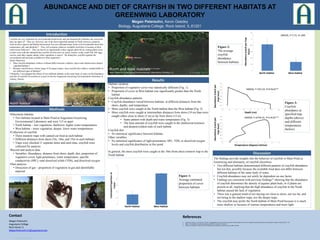
Petersohn_Megan - Celebration of Learning
- 1. ABUNDANCE AND DIET OF CRAYFISH IN TWO DIFFERENT HABITATS AT GREENWING LABORATORY Megan Petersohn, Kevin Geedey Biology, Augustana College, Rock Island, IL 61201 Megan Petersohn Augustana College Rock Island, IL MeganPetersohn11@augustana.edu Contact 1. Loughman, Zachary J., and Thomas P. Simon. "Zoogeography, Taxonomy, And Conservation Of West Virginia's Ohio River Floodplain Crayfishes (Decapoda, Cambaridae)." Zookeys 74.Spec (2011): 1-78. 2. Page, L. The Crayfishes and Shrimps (Decapoda) of Illinois. Volume: 33 Article: 4 3. Voshell JR. Crayfishes. A Guide to Common Freshwater Invertebrates of North America. 2002. P 254-58. References Figure 2: The average crayfish abundance between habitats Introduction The findings provide insights into the behavior of crayfish in Main Pond at Greenwing and ultimately, of crayfish elsewhere. • Two different habitats demonstrated different patterns of crayfish abundance but not diet, possibly because the available food does not differ between different habitats of the same body of water. • Crayfish abundance may not solely be dependent on one factor • Findings are consistent with previous findings23 showing that the abundance of crayfish determines the density of aquatic plant beds, or if plants are present at all, implying that the high abundance of crayfish in the North habitat caused the lack of vegetation. • There was a general trend of not staying too close to shore, nor too far, and not being in the shallow traps, nor the deeper traps. • The crayfish may prefer the North habitat of Main Pond because it is much more shallow or because of warmer temperatures and more light. Discussion Crayfish are very important for environmental biodiversity and can dramatically influence the ecosystem they are apart of3. They are, however, one of the most imperiled animals in North America, primarily from invasive species and habitat destruction1 but can withstand many forms of environmental stress like temperature, pH, and alkalinity23. They will consume whatever available food there is because of their omnivorous behavior23. They are known to significantly reduce aquatic plant life by cutting plants close to their roots with the chelipeds but crayfish will also prey on snails, insects, scuds, small fish, fish eggs, carrion, and other organic matter when vegetation is scarce3. By doing this, crayfish regulate the environment and nutrients available for other organisms3. Study Objectives • Does crayfish abundance within a wetland differ between a shallow, open water habitat and a deeper, vegetated habitat.? • Because crayfish have a home range of 30 square meters, does crayfish diet within a wetland differ in two different types of habitats? Ultimately, I investigated the effects of two different habitats in the same body of water on the abundance and diet of crayfish (Procambarus acutus) at the the Augustana Greenwing Environmental Laboratory in Amboy, Illinois. Habitat variation • Proportion of vegetative cover was statistically different (Fig. 1) • Proportion of cover in West habitat was significantly greater than the North habitat Crayfish abundance patterns • Crayfish abundance varied between habitats, at different distances from the shore, depths, and temperature • More crayfish were caught in the North habitat than the West habitat (Fig. 2) • More crayfish were caught at intermediate distances from shore (10 m) than were caught either close to shore (5 m) or far from shore (15 m) • Same pattern with depth and water temperature (Fig. 3) • The least amount of crayfish were caught in the shallowest/warmest and deepest/coldest ends of each habitat Crayfish diet • No statistical significance between habitats Other variables • No statistical significance of light penetration, SPC, TDS, or dissolved oxygen levels and crayfish distribution in this pond In general, the most crayfish were caught in the 10m-from-shore minnow trap in the North habitat Figure 1: Average estimated proportion of cover between habitats •Determine habitats • Two habitats located in Main Pond at Augustana Greenwing Environmental Laboratory and were 115 m apart • North habitat – less vegetation, shallower, higher water temperatures • West habitat – more vegetation, deeper, lower water temperatures •Collection of crayfish • Three minnow traps with canned cat food at each habitat • Different distances from shore (5m, 10m, and 15m in each habitat) • Traps were checked 11 separate times and each time, crayfish were collected for analysis •Record and analyze data • Variables: Abundance, distance from shore, depth, diet, proportion of vegetative cover, light penetrance, water temperature, specific conductivity (SPC), total dissolved solids (TDS), and dissolved oxygen •Diet analysis • Dissection of gut – proportion of vegetation in gut and identifiable material North and West Habitats Main Pond in Greenwing Environmental Laboratory (Amboy, IL) West HabitatNorth Habitat 0 0.2 0.4 0.6 0.8 1 1.2 EstimatedProportionof Cover 0 0.02 0.04 0.06 0.08 0.1 0.12 Abundance(catchpertrap hour) 0 0.02 0.04 0.06 0.08 0.1 0.12 0.14 0.16 20 30 40 50 60 70 80 90 100 Abundance(catchper traphour) Depth (cm) ANOVA, F=353.33, P<6.9x10-39 North Habitat West Habitat Results Methods ANOVA, F=7.15, P<.009 North Habitat West Habitat Figure 3: Crayfish abundance at specified trap depths (above) and different temperatures (below) 0 0.02 0.04 0.06 0.08 0.1 0.12 0.14 0.16 18 19 20 21 22 23 24 25 26 Abundance(catchper traphour) Temperature (degrees Celcius) ANOVA, F=6759.33, P<5.9x10-114